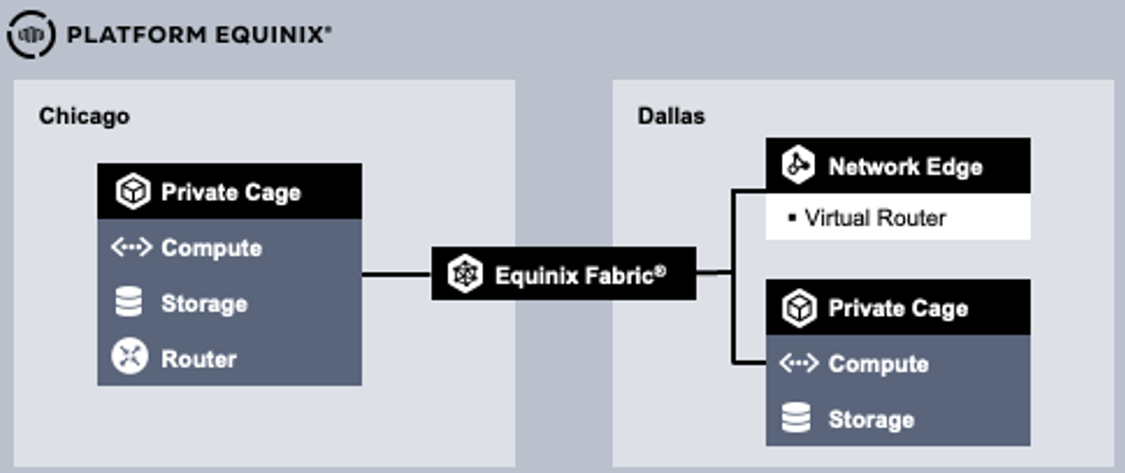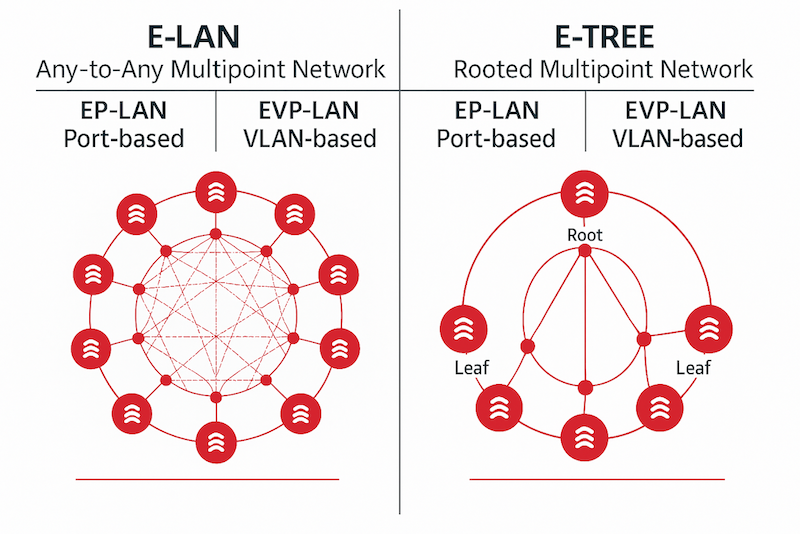Data Center Interconnect
This topic provides high-level guidance on various methods available through Equinix Fabric to build a Layer 2 Data Center Interconnect (DCI) between two or more Equinix Fabric locations. With availability in over 60 Equinix metros globally, Equinix Fabric offers an automated solution to provision network services on demand, for any duration.
DCI enables connectivity within or between Equinix metros to share resources, data, or other assets with rapid elasticity, high availability, and scalability.

Point-to-Point (P2P) Connection Types
Equinix Fabric offers both VLAN-based Ethernet Virtual Private Line (EVPL) and port-based Ethernet Private Line (EPL) options. EVPL and EPL P2P DCI connections can be made between two Fabric metros at various bandwidths ranging from 10Mbps to 50Gbps. You can review the maximum bandwidth speeds between metro here.
-
EVPL (VLAN-based) – EVPL connections originate from an EVPL (.1q or QinQ) Fabric port that can support multiple virtual connections or VLANs from the same port. If you want to use your Fabric port to connect to multiple Fabric destinations (for example, your own private network as well as CSPs), then EVPL should be a consideration.
-
EPL (Port-based) – EPL connections originate from an EPL port that is transparent and protocol agnostic. Only one connection can be created to/from an EPL port because all traffic is passed without segmentation. If you want to pass multiple VLANs to the same destination, or if you want to enable encryption protocols such as MACSec across your connection, then EPL should be a consideration.
For more information about port types and VLAN tag handling on Fabric, see Port Architectures and Port Traffic and Tagging.
Multipoint-to-Multipoint (MP2MP) Connection Types (E-LAN)
Customers with three or more Equinix locations may interconnect their assets using Equinix Fabric’s EVP-LAN or EP-LAN private networks. EVP-LAN and EP-LAN are two types of E-LANs, or Ethernet LAN connectivity options.
MP2MP delivers symmetrical bandwidth for data sent in either direction at provisioned connection speeds (full mesh). Each virtual connection will have its own bandwidth speed (up to 10Gbps).
All connections to the customer’s private network or E-LAN must be made from the same account (single customer). Multi-customer private networks will be delivered in a future release.
Equinix Fabric‘s E-LAN Services
Customers with three or more Equinix locations may interconnect their assets using Equinix Fabric’s E-LAN or E-Tree private network services. Equinix supports the port and VLAN based versions of these services. E-LAN is an any-to-any network service and E-Tree is a rooted multipoint network service.

MP2MP services deliver symmetrical bandwidth for data sent in either direction at provisioned connection speeds (full mesh). Each virtual connection will have its own bandwidth speed (up to 25Gbps).
All connections to the customer’s private network can be made from the same account (single customer), or from customers in a different organization using a token provided by the network owner. Network owners can support token-based connections either by providing a Z-side network token to a connection creator or by initiating a connection using an A-side token from a resource owner on Fabric.
For more information about port types and VLAN tag handling on Fabric, see Port Architectures and Port Traffic and Tagging.
For more information about creating and managing multipoint networks, see Multipoint-to-Multipoint Networking.
EVPL VCs (either for P2P or MP2MP) will not pass Layer 2 Control Protocol (L2CP) traffic. This traffic is blocked by design at the port/UNI and its behavior cannot be changed. Some examples of commonly used L2CPs are STP, CDP, and LACP. If L2CP is required, customers use EPL.
WAN MACsec
WAN MACsec provides MACsec encryption at rates that aligned with Ethernet standards while also providing enhancements that allowed operators to leverage carrier Ethernet offerings (802.1Q) and allow the router supporting WAN MACsec to adjust to the multitude and inconsistent forwarding of certain protocols, MAC addresses, and Ethertypes. WAN MACsec gives operators the flexibility to virtually run over any public carrier Ethernet service, simplifying installations, while offering design capabilities with MACsec never seen before over public Ethernet transport. For a detailed examination of interconnection over Fabric using WAN MACsec, see (Securing High-Speed Interconnection Over Equinix Fabric Using Cisco WAN MACsec For Public And Private Sector).
EPL Use Case – Inter Metro DCI with MACsec (or without)
This example shows a typical EPL configuration. Many other use cases are supported.
Use Case: As an Equinix Fabric user, I want to leverage MACsec encryption to secure network traffic between metros.

*Transparent to all except Ethernet pause frames.
Requirements for a typical EPL configuration:
-
Two 1G, 10G, or 100G Fabric EPL ports
-
One VC (any size)
Advantages:
-
Multiple VLANs are transparently tunneled across Equinix Fabric within one VC
-
Customer-provided MACsec is supported over an EPL VC